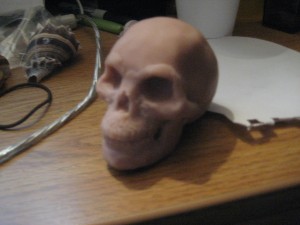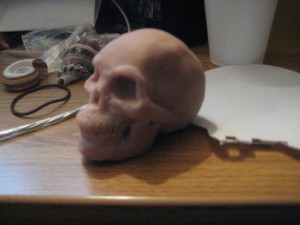 This week in Illustration, the class built human skulls out of super sculpey, a “ceramic like” polymer clay that hardens after baking. Fresh out of the box the sculpey is quite rigid, but the heat from your hands start a chemical reaction that softens the clay as you work. This is useful if you have a tool handy to NOT heat up the clay. Because you can control how soft the clay gets as you work with it depending on whether you use your hands or the tool to do most of the molding. It you need a very thin, flexible peace, just kneed it with your hands for a while longer.
This week in Illustration, the class built human skulls out of super sculpey, a “ceramic like” polymer clay that hardens after baking. Fresh out of the box the sculpey is quite rigid, but the heat from your hands start a chemical reaction that softens the clay as you work. This is useful if you have a tool handy to NOT heat up the clay. Because you can control how soft the clay gets as you work with it depending on whether you use your hands or the tool to do most of the molding. It you need a very thin, flexible peace, just kneed it with your hands for a while longer.
To make this skull, that is exactly one-third the size of a real human skull, we started with a crumpled up piece of tinfoil that we made about one-third the size of the brain. This took away some of the weight of the final product and was an easy and bake-able armature to work around. Once we had our brain, we sculpted the cranium with the help of a diagram on paper. We constantly compared our work to the reference on paper to make sure that everything was in proportion. The paper pattern showed the skull from all angles in simple, and complex detail.
 We added eye sockets to the cranium and baked it. After the cranium was hardened, we began to sculpt the facial bones, again comparing our work to the paper pattern. The finished product was then baked again and we had a perfect little skull. In class, we also made muscles and flesh to go over the bones so that we could see how much of the face is made up of bone. It really is amazing how the bone structure absolutely defines what the face will look like down to the smallest detail.
We added eye sockets to the cranium and baked it. After the cranium was hardened, we began to sculpt the facial bones, again comparing our work to the paper pattern. The finished product was then baked again and we had a perfect little skull. In class, we also made muscles and flesh to go over the bones so that we could see how much of the face is made up of bone. It really is amazing how the bone structure absolutely defines what the face will look like down to the smallest detail.
